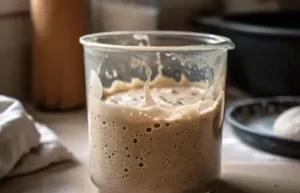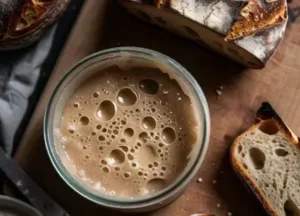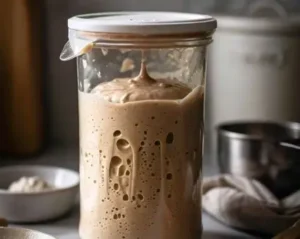Perfect Sourdough Starter Recipe at Home
Now, if you have a dream, it’s easy to get fascinated with other baking skills, and surely making this crusty tangy sourdough bread is one of them. There’s one thing standing between us and that perfect loaf, and that’s our ability to create an active, fun sourdough starter. And the living cultures are wild yeast and bacteria; they make tasty, naturally sourdough bread.

However, it is vital to note that making your sourdough starter at home is way easier than many people would want you to think. It doesn’t take too much time to make a starter, just 3 ingredients: flour, water, and a little more time to discover how to bake a healthy dough that will help you to give your bread that extra boost you need to move up to the next level.
It’s the first sourdough recipe that any home baker can try and have a good go at making a wide range of artisan breads from your kitchen. I have 20 years of experience in cooking. So you can trust me.
The Basics of Sourdough Starters
I think anybody would need some basic facts so that we could bake sourdough starters at home. If you’re looking for the best sourdough starter recipe, or you want to know how to make a sourdough starter, this is it. So let’s begin with how to care for a sourdough starter.
What is a Sourdough Starter?
A dough leavened by the use of wild yeast and some bacterium during the fermentation process is referred to as a sourdough starter. But if the finished product is to be that type – a sourdough and this porous that can only be done with that living culture. If you have some time, 5 to 7 days is enough for making starter sour for baking stuff.
Ingredients for an Easy Sourdough Starter Recipe
When generating a learning sourdough starter recipe, there is no need to search for exotic products. You’ll need:
- Flour (preferably whole wheat or rye for starting)
- Water (filtered or spring water is best)
- A clean glass or ceramic container
- A breathable cover (like a coffee filter or cloth)
The Feeding Process
Taking care of your starter more or less simulates the process of lacto-fermentation in which the bacteria are fed with fresh flour and water. This process helps maintain yeast and bacteria in the right condition so as to become active and healthy.
Sourdough starter maintenance: beginners can try to feed the starter once a day and maintain the room temperature and if you bake once a week, you place the starter in the refrigerator and feed it weekly.
Signs of a Healthy Starter
An active and healthy starter should double its volume in 4- 8 hours after it has been fed and should smell like vinegar. Foam on the surface and in the mass is evidence of fermentation processes. If your starter isn’t exhibiting those signs, do not panic, bringing alterations in the feeding ratio or the temperature usually helps.
Best Flours for Making Sourdough Starters
The first decision you must make at the start of your journey of building the best sourdough starter recipe is, what flour will you be using. You do not want to change the type of flour you are using for your starter—this can make it taste or feel radically different. Here are a few most recommended traditional sourdough starter recipe ideas to follow successfully.

Whole Wheat Flour: The Classic Choice
One ingredient that is popular when it comes to the simplest sourdough starter recipe is whole wheat flour. That is why it has a high nutrient content that allows wild yeast and bacteria to feed on it to build up your starter. Whole wheat flour contains natural enzymes that cause the breakdown of complex carbohydrates, which are favorable for microorganisms.
Rye Flour: The Powerhouse
If you are interested in using ingredients to make your starter stronger or faster, rye flour is a great addition. It is rich in nutrients and fermentable sugars so it will come in handy to anyone wondering what to use in creating a very active sourdough starter.
All you need is rye flour to give you that perfectly rising dough in no time because well, impatience is a virtue.
All-Purpose Flour: The Reliable Staple
All-purpose flour is very reliable when first learning how to make a sourdough starter. You can’t go wrong with that too it is both protein and starch and easy to get to. Though it has less nutrient value than whole grain, it does a fine job of producing a healthy, active starter to be fed routinely.
Experimenting with Flour Blends
The majority of veteran bakers appreciate the disjointed utilization of the various flours in the production process. For example, using both whole wheat flour and all-purpose flour in the same loaf will offer the customers both nutrient-dense and a standardized product.
Always feel free to tinker with the ratio of ingredients to arrive at which is best for your tastes and baked goods requirements. Just a reminder that it does not matter which flour you decide to use, but make sure that you feed and take care of your starter the same way, every time.
Give it a little time, attention, and love and you will be rewarded with a nice, bubbly starter you can shape into beautiful sourdough bread.
Easy Old Fashioned Sourdough Starter Recipe
Becoming part of a long tradition of bread making is an interesting process, starting your own sourdough starter. The simple steps to create a sourdough starter will allow the commercial yeast to grow a fabulous wild yeast and bacteria culture in order to give you great bread.
Ingredients and Equipment
To begin your sourdough adventure, you’ll need just a few simple items:
- 1 cup (120g) whole wheat flour
- 1 cup (120g) all-purpose flour
- 1 cup (240ml) lukewarm water
- A clean glass or ceramic container
- A kitchen scale (optional but recommended)
The Process
This old-fashioned sourdough starter recipe is remarkably straightforward:
- In your container for the whole wheat flour mixture, measure equal parts of flour to water.
- Let cover lightly for 24 hours at room temperature.
- Spoon off the top half of the mixture and then add a mixture of one part flour to one part water.
- Continue with step 3, and perform it daily for five to seven days or more to make your starter active and full of bubbles.
Signs of Success
As you follow this beginner sourdough starter recipe, look for these indicators of a healthy culture:
- A pleasant, tangy aroma
- Consistent bubbling and expansion after feeding
- Doubling in size within 4-8 hours of feeding
The best way to digest this is that patience is key with a sourdough starter. A recipe for a sourdough starter containing the time needed for the natural fermentation to take place is the easiest.
When you follow this simple sourdough starter recipe you will have a growing culture that can be used to bake bread at home. Moreover, using the intended method reduces yield to high quality and tasty bread without forgetting the generations’ tradition of baking.
How to Make a Sourdough Starter from Scratch
Starting your sourdough starter is a fun process to embark upon to open the door towards homemade bread. From this simple sourdough starter recipe, you will learn how to create your wild yeast culture starter.

Gather Your Ingredients
To begin your sourdough journey, you’ll need just two simple ingredients:
- Whole wheat flour or rye flour
- Filtered water (chlorine-free)
By incorporating whole grain flour into your dough, you offer the wild yeast and bacteria a better profile to feed on while starting your culture.
The Initial Mix
To kick off a best sourdough starter recipe, use equal proportions of flour and water when measuring using a kitchen scale. A good starting point is:
- 50 grams of whole wheat flour
- 50 grams room temperature water
Pour these into a clean glass or ceramic container until there is no dry flour at the bottom of the container. Place lid or cloth loosely on top and let it stand in the kitchen roughly for a day at room temperature of 70°F/21°C).
Daily Feedings
For the next 5-7 days, you’ll need to “feed” your starter daily:
- Discard all but 50 grams of the mixture.
- Add 50 grams of flour and 50 grams of water.
- Mix well and cover.
This conventional sourdough starter recipe procedure imitates conventional methods that people used for many decades. When you do this you will sense increased starter activity, it should have a nice pleasant sour smell and be dotted with small bubbles.
Signs of Success
Your beginner sourdough starter recipe is ready when it has doubled in size within 4-8 hours after feeding and has a tangy smell. This signifies that you have been able to isolate a variety of wild yeast and fiber-friendly bacteria, a fact that points to the fact that your ingredients are truly alive.
And by reading this guide on how to make a sourdough starter, you’re doing more than just making a leavening – you’re carrying forward a tradition. If you take your time and have some basic knowledge in the kitchen, your homemade starter will allow you to bake countless great-tasting, completely natural homemade bread.
Maintaining and Feeding Your Sourdough Starter
Well done for coming up with this simple sourdough starter for beginners recipe! You have learned how to make a sourdough starter Now learn different techniques used to maintain the same. To maintain your starter active, and ready to be used for creating more sourdough bread whenever you feel like it, you need to look after it properly.
Feeding Schedule
The most crucial thing about the survival of a starter is feeding it. For an easy sourdough starter recipe maintenance routine:
- Remove half of your starter (discard or use in other recipes).
- Add equal parts flour and water to the remaining starter.
- Mix well and let it sit at room temperature.
If you bake on a daily basis, perform this regimen daily; if baking is occasional, as is with many households, then weekly is adequate. This is a very old-fashioned sourdough starter recipe technique that proved to be quite successful.
Choosing the Right Flour
Though the best sourdough starter recipe may include other flours, many prefer:
- Unbleached all-purpose flour
- Whole wheat flour
- Rye flour
You can try varying the flours and see which starter stretches the hardest and which provides the taste you desire.
Storage Options
Your lifestyle will determine how you store your starter:
- Room temperature: Ideal for daily bakers, requiring daily feedings.
- Refrigeration: Perfect for weekly bakers, needing feeding only once a week.
However, a cold starter requires some time to get warm or active for use in baking or any other baking activity.
Troubleshooting Common Issues
Even with the best care, your starter may encounter problems. Look out for:
- Mold growth (discard and start over)
- Liquid on top (normal, just stir it in)
- Lack of activity (try feeding more frequently)
That way your sourdough starter will remain active and colorful for the preparation of more loaves of homemade bread. Happy baking!
Using Your Mature Sourdough Starter
Congratulations! You have, therefore, started your sourdough starter by following the best sourdough starter recipe. Well, now ‘it’s time to use that bubbly mixture for something productive. Here are the guidelines on how to get the best out of your mature starter and end up with some yummy homemade bread.

Testing for Readiness
One last very important note before we get started baking, always make sure that your starter is active. A mature starter should in fact double its size in 4-8 hours after feeding. To test its readiness, try the float test: and add a pinch of starter into a glass of water. If it floats, then it’s ready for use in your old-fashioned sourdough starter recipe.
Feeding and Maintenance
As you can see, taking care of your starter is what will keep it going for quite some time. For an easy sourdough starter recipe maintenance routine:
- Discard all but 1/4 cup of starter
- Add 1/2 cup flour and 1/4 cup water
- Mix well and let sit at room temperature
Practice this routine every day if you bake more products, or every week if you bake fewer products. It is important to bear in mind that longevity is equally important when you are learning how to maintain a sourdough starter.
Baking Your First Loaf
Okay, the fun begins – baking your first loaf of bread! Here’s what to consider when using your beginner sourdough starter recipe:
- Use the starter at its peak activity, usually 4-8 hours after feeding
- Follow your chosen recipe closely, paying attention to hydration levels
- Be patient during the fermentation and proofing stages
As you will get used to the behavior of your starter you will achieve superb artisan bread at your home.
Storing Your Starter
If you do not bake regularly, your starter can be stored in the refrigerator. Take it to the vet once a week to be fed in order to ensure it is alive. When you wish to use it again for baking, let it rise at room temperature then feed it daily until it becomes active again. It helps to always have an active starter within reach so it’s always prepared for the next round of sourdough magic.
Troubleshooting Common Sourdough Starter Problems
Doubling the perfect starter may be quite challenging, even when using the best sourdough starter recipe. Here are some common issues you might encounter and how to solve them:
Starter Not Rising
If your starter isn’t rising, then it may be starved and inactive. This is a common issue that you should face if you maintain an old-fashioned sourdough starter recipe from a book. To fix this:
- Ensure you’re feeding your starter regularly
- Keep it in a warm spot (around 70-80°F)
- Use filtered water to avoid chlorine, which can inhibit growth
- Try adding a pinch of rye flour to boost activity
Unpleasant Odor
A healthy starter should smell tangy and pleasant. If yours has a strong, unpleasant odor:
- Discard all but a tablespoon and feed with fresh flour and water
- Ensure your container is clean
- Feed more frequently to prevent over-fermentation
Mold Growth
Mold is usually an indication that something is off with your easy sourdough starter recipe. If you see any:
- Discard the entire batch
- Clean your container thoroughly
- Start over with a new beginner sourdough starter recipe
Liquid Separation
The fact that it is bubbly and a dark liquid – hooch on top of your starter means that it’s hungry. To remedy this:
- Pour off the liquid
- Feed your starter more frequently
- Adjust your flour-to-water ratio
Always remember that practicing how to make a sourdough starter is one of the most important things in learning. It is perfectly normal for bakers, nevertheless, experienced pastry chefs face some problems from time to time.
This is where people must be quite consistent with their feeding schedule, and wait for the baby to get used to the new feeding timetable. Patience and effort will help you to achieve the skill of managing a glowing, active starter to bake tasty homemade bread.
Creative Ways to Use Excess Sourdough Starter
In case you’re managing your best sourdough starter recipe, you may regularly end up with an extra starter. Do not throw it away and consider these ideas below which help you to reduce waste and enhance the taste in your home kitchen.

Savory Sourdough Crackers
If you are using a traditional sourdough starter recipe discard then it’s time to turn it into crunchy tangy crackers. Stir the remaining starter with some flour, and add some oil and spices if preferred. Knead well, flatten, cut into desired forms, and bake till brown. Vegetarian, gluten-free, and great for cheese boards or as a crunchy snack!
Fluffy Pancakes and Waffles
Rotate your savory breakfast meal by using sourdough discard in your pancake or waffle batter. Even the simplest of breakfast foods, the fermented taste brings out the richness of the dishes. However, it is advisable to let the batter rise for a much longer time – the next day if possible to encourage the development of the sourdough flavor.
Rustic Pizza Crust
It is better to add too much starter and then use it to make a delicious pizza crust. You add discard, flour, water, and a pinch of salt and make a no-knead dough. You may let it rise for a few hours or even let it rise all night for a sourdough base that has just the right texture and taste for your toppings.
Sourdough Banana Bread
Here’s how to use your sourdough starter discard to make a tasty banana bread. Another flavor that goes well with bananas due to the fermentation process is sweet which makes this loaf moist and delicious. This is a simple variation of the basic sourdough starter recipe that helps use up both, the extra portions of the starter and ripe bananas.
Zesty Salad Dressing
Learn how to repurpose your discarded sourdough starter by incorporating it into a salad dressing recipe of your choice – olive oil, vinegar, and fresh herbs. It makes the all-important starter rather tangy which can infuse the dressing, leaving a fresh and pleasant taste after washing down greens and vegetables.
Finding out these creative ways will make you realize that learning how to make a sourdough starter is more than just the bread. In addition to improving your beginner sourdough starter recipe, you will learn how to use this ingredient to enrich other dishes and thus minimize their spoilage, expanding your culinary horizons.
Conclusion
In as much as you start out baking your first Sourdough bread remember that the process requires a lot of time and diligence. Your starter will evolve into an entity and needs attention. However, the pleasure that anyone will get from fermenting their bread right from a sourdough start is so fulfilling that no one should bother thinking twice. Over time, you will learn what kind of starter your little one needs and how it acts.
Soon you will be making breads as perfect as those made in professional bakeries that you’ve wished to produce. So get comfortable with the process, be creative when it comes to pairing flavors, and over to family and close friends with your new dishes.
If you’re lucky enough to bake your bread, your digestive system will be the beneficiary, as will your soul and your connection to this ancient craft.
Frequently Asked Questions (FAQs)
What is the best sourdough starter recipe for beginners?
The simplest sourdough starter recipe is the perfect recipe for a beginner as with any kind of bread. You monitor a most basic sourdough starter by replenishing it equally with equal parts each day and require equal parts flour and water for it.
While this may be an old-fashioned sourdough starter recipe, it is the perfect place to start sourdough for a beginner in the discipline.
How long does it take to make a sourdough starter?
In as much as learning how to make a sourdough starter is easy, patience is crucial when preparing it. It takes about 5-7 days usually, and sometimes it goes up to two weeks. At this stage, the only thing you have to do is feed your starter daily and observe its fermentation processes: bubbles should appear and the smell should be sour.
Can I use different types of flour for my starter?
Of course, you have the option to substitute different flours. While most bakers may choose to use whole wheat or rye flour to first start the fermentation process, you can use plain flour. Some even use mixed flour to get different tastes in the final product of bread or biscuits. You need to be very consistent with the feeding regardless of the type of flour you are using.
How do I know if my sourdough starter is ready to use?
Ideally, a mature starter should increase in vol two-fold fold within 4-8 hours after feeding and emit a pleasant sour-smelling odor. To test its readiness, try the float test: place a small quantity of starter into a glass of water. If food takes to water, it is nearly ready for the baking process. Also, it is to be noted that completing the beginner sourdough starter recipe requires patience dedication to reading/ar an eye for detail.
About Us:
Ben Starr Sourdough Starter Recipe
Best Sourdough English Muffins Recipe Ever
Best Sourdough Rolls Recipe With Starter
Traditional Shortbread Christmas Cookies Recipe

Hello! My name is Wahab Khan. I, having over 20 years of culinary experience, bring both my knowledge and passion to each Recipe featured here. I create delicious, accessible dishes for beginners and seasoned cooks alike, and think that good food can help connect people. My recipes combine timeless techniques with stellar new spins, allowing readers to master the everyday flavors of the World.
